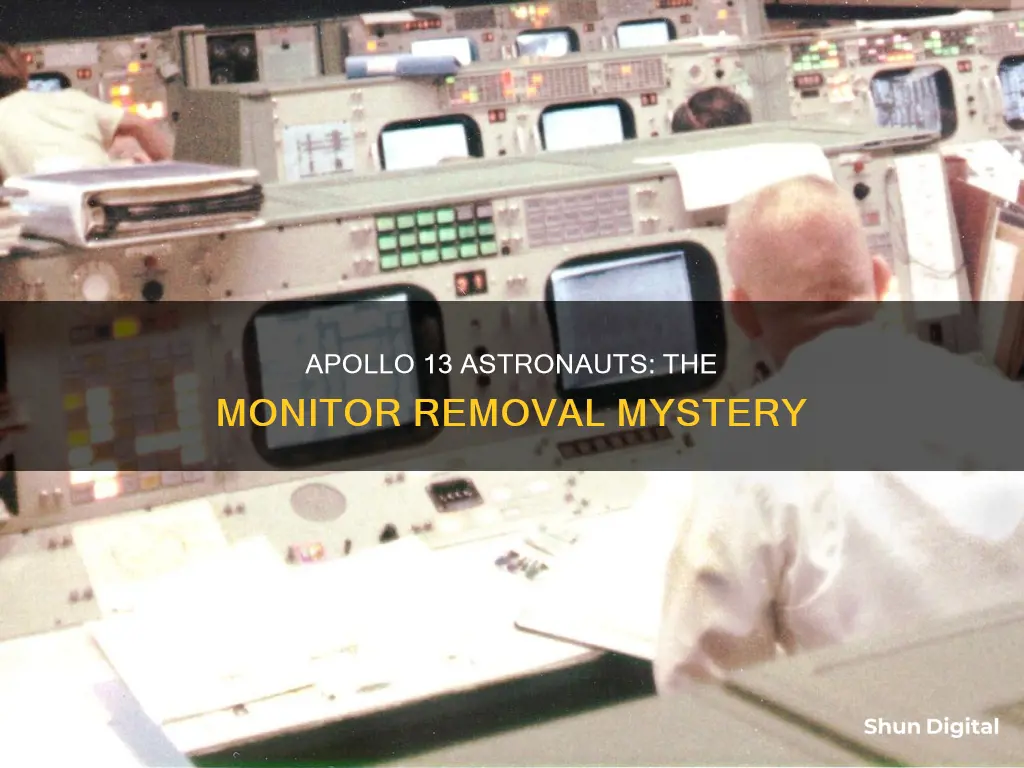
The Apollo 13 mission, NASA's third moon-landing mission, was aborted after an oxygen tank explosion damaged the spacecraft. The three astronauts on board, commander James Lovell, lunar module pilot Fred Haise, and command module pilot John Jack Swigert, were forced to seek shelter in the lunar module for the trip back to Earth.
The lunar module was designed to support two men on the lunar surface for two days, but Mission Control in Houston improvised new procedures to support three men for four days. The crew experienced great hardship due to limited power, a chilly and wet cabin, and a shortage of potable water.
The astronauts removed their medical telemetry, which monitored their vital signs, in defiance of mission rules. This action was depicted in the 1995 film Apollo 13, although the removal of the sensors was likely not performed in the dramatic fashion shown in the film.
| Characteristics | Values |
|---|---|
| Date of Apollo 13 mission | 11th-17th April 1970 |
| Astronauts | James Lovell, Fred Haise, Jack Swigert |
| Cause of explosion | Spark from exposed wire in oxygen tank |
| Location of explosion | Oxygen tank no.2 |
| Time of explosion | 56 hours into the flight |
| Explosion caused by | Combination of manufacturing and testing errors |
| Explosion led to | Loss of primary means of generating power and supporting life |
| Explosion was a | "Successful failure" |
What You'll Learn

The explosion
The Apollo 13 explosion was caused by a spark from an exposed wire in one of the spacecraft's oxygen tanks. The explosion took place on April 13, 1970, when the crew was nearly 322,000 kilometers (200,000 miles) from Earth and closing in on the moon.
This fire ripped apart one oxygen tank and damaged another, leading to a rapid loss of oxygen and power. The oxygen tanks fed the fuel cells in the spacecraft, so the power was quickly reduced, and the spacecraft's attitude control thrusters tried to stabilize it by firing small jets. However, several of these jets were slammed shut by the explosion, making the situation worse.
The Lifeboat
The lunar module was only designed to hold two people, but all three astronauts—commander James Lovell, lunar module pilot Fred Haise, and command module pilot Jack Swigert—crammed inside for the journey back. It was a challenging and uncomfortable trip, with cabin temperatures dropping close to freezing and limited food and water. The crew had to carefully ration their resources to ensure they would last until they reached Earth.
During the trip, the crew powered down every non-essential system to conserve power and performed a crucial burn to point the spacecraft back towards Earth. Aquarius did not have a heat shield, so it would not survive the re-entry, but it protected the crew and carried them safely until they could transfer back to the command module, Odyssey, for the final stages of their journey.
Monitoring Router Bandwidth Usage: A Step-by-Step Guide
You may want to see also

The astronauts' response
The Apollo 13 mission was NASA's third moon-landing mission. The crew included commander James Lovell, lunar module pilot Fred Haise, and command module pilot John "Jack" Swigert.
The astronauts were calm and collected despite the danger of the situation. They were able to seek shelter in the lunar module for the trip back to Earth.
The crew faced many challenges, including a lack of food and water, extreme cold, and a shortage of power. They had to balance the challenge of getting home with the challenge of preserving power. They had to make do with very little food and water, and the entire spaceflight crew lost weight. Haise developed a kidney infection.
The astronauts were also able to improvise solutions to some of their problems. For example, they used plastic covers, duct tape, and other items available on the spacecraft to address the problem of removing carbon dioxide.
The crew's calm and collected response, along with the efforts of mission control and spacecraft manufacturers, ultimately led to the successful return of the Apollo 13 crew.
Monitoring at Work: Am I Being Watched?
You may want to see also

Mission Control's response
The Apollo 13 mission was NASA's third moon-landing mission, but the astronauts never made it to the lunar surface. The mission is described as a "successful failure" because, despite the astronauts failing to reach the moon, the mission was a success in that it brought the crew back to Earth safely.
The mission was commanded by Jim Lovell, with Jack Swigert as command module pilot and Fred Haise as lunar module pilot. The crew were about 200,000 miles from Earth when, 55 hours into the mission, an oxygen tank explosion damaged the spacecraft. The crew were forced to abandon their mission and seek shelter in the lunar module for the trip back to Earth.
The explosion caused a loss of power and oxygen, and the lunar module was not designed to support three men for the return journey. Mission Control in Houston improvised new procedures so that the lunar module could support the crew for four days. The crew experienced great hardship, caused by limited power, a chilly and wet cabin, and a shortage of potable water.
The astronauts' peril briefly renewed public interest in the Apollo program. Tens of millions watched the splashdown in the South Pacific Ocean on television.
The mission's success is largely attributed to the hundreds of simulated missions that had been carried out by the controllers and the astronauts. This meant that when things went wrong, there was always some kind of contingency plan in place.
The Apollo 13 Accident Review Board identified the cause of the explosion as a damaged oxygen tank. The tank had been dropped during a pre-launch test, and although no damage was found, internal wiring had been damaged. During a final test on the launchpad, the heaters were on for a long period, causing the wiring to degrade.
The explosion occurred when a spark from an exposed wire in the oxygen tank caused a fire, ripping apart one oxygen tank and damaging another inside the spacecraft.
Dismantling the Asus MG28UQ Monitor: Step-by-Step Guide
You may want to see also

The lunar module as a 'lifeboat'
The lunar module, Aquarius, was used as a lifeboat for the crew of Apollo 13 after an oxygen tank explosion on the service module, Odyssey, crippled the spacecraft. The astronauts were forced to abandon the idea of landing on the moon and instead sought shelter in the lunar module for the trip back to Earth.
The lunar module was designed to support two men on the lunar surface for two days. However, Mission Control in Houston improvised new procedures so it could support three men for four days. The crew experienced great hardship, caused by limited power, a chilly and wet cabin, and a shortage of potable water.
The lunar module had charged batteries and full oxygen tanks for use on the lunar surface. It also had untapped supplies of electric power, and two powerful engines, the most useful of which was the Descent Propulsion System (DPS). The DPS engine was used to perform an abort burn once the crew passed the Moon to get them back home.
The crew had to balance the challenge of getting home with the challenge of preserving power on the lunar module. After they performed a crucial burn to point the spacecraft back toward Earth, the crew powered down every nonessential system. Without a source of heat, cabin temperatures quickly dropped down close to freezing. Some food became inedible. The crew also rationed water to make sure the lunar module—operating for longer than it was designed—would have enough liquid to cool its hardware.
The small vessel protected and carried the crew long enough to reach Earth's atmosphere. The crew only returned to the command module in the hours before splashdown to power it up and begin their reentry.
Understanding Monitor Resolution: Finding Your P Value
You may want to see also

The return to Earth
The Apollo 13 astronauts—commander James Lovell, lunar module pilot Fred Haise, and command module pilot John "Jack" Swigert—had to abandon their mission to land on the Moon after an oxygen tank explosion damaged their spacecraft. The crew sought shelter in the lunar module, Aquarius, which was designed to land on the Moon and had enough oxygen, but not enough heat, for the journey back to Earth. The command module, Odyssey, was powered down to preserve its resources for re-entry.
The crew had to endure freezing temperatures and food shortages during the long, cold journey home. They also had to ration water to ensure the hardware could be kept cool. The small vessel also lacked a heat shield, which would be necessary for re-entry into Earth's atmosphere.
In the hours before splashdown, the exhausted crew powered up the Odyssey and jettisoned the service module. They then moved back into the command module, which had been in a cold-water soak for days, and began their re-entry.
On April 17, 1970, the astronauts safely splashed down in the Pacific Ocean near Samoa. The entire spaceflight crew lost weight, and Haise developed a kidney infection.
Spyware Detection: Enhancing Monitoring with Counter Surveillance Techniques
You may want to see also
Frequently asked questions
Yes, the crew of Apollo 13 survived, despite the mission failing to reach the moon. The crew included commander James Lovell, lunar module pilot Fred Haise, and command module pilot John "Jack" Swigert.
A series of problems plagued the Odyssey spacecraft, which was designed to bring the crew home, causing the crew to abandon all thoughts of reaching the moon. A fire ripped through one of Odyssey's oxygen tanks and damaged another. Oxygen fed the fuel cells in the spacecraft, so power was also reduced.
The crew used their lunar lander, Aquarius, as a makeshift 'lifeboat'. It was a rough journey home. The entire spaceflight crew lost weight, and Fred Haise developed a kidney infection. But the small vessel protected and carried the crew long enough to reach Earth's atmosphere.
A spark from an exposed wire in the oxygen tank caused a fire, ripping apart one oxygen tank and damaging another inside the spacecraft.







